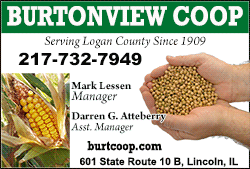|
 Depending on the applicant’s needs, there are three types of
Direct Farm Ownership Loans: regular, down payment and joint
financing. FSA also offers a Direct Farm Ownership Microloan
option for smaller financial needs up to $50,000. Depending on the applicant’s needs, there are three types of
Direct Farm Ownership Loans: regular, down payment and joint
financing. FSA also offers a Direct Farm Ownership Microloan
option for smaller financial needs up to $50,000.
Joint financing allows FSA to provide more farmers and ranchers
with access to capital. FSA lends up to 50 percent of the total
amount financed. A commercial lender, a State program or the
seller of the property being purchased, provides the balance of
loan funds, with or without an FSA guarantee. The maximum loan
amount for a Joint Financing loan is $600,000 and the repayment
period for the loan is up to 40 years.
To be eligible, the operation must be an eligible farm
enterprise. Farm Ownership loan funds cannot be used to finance
nonfarm enterprises and all applicants must be able to meet
general eligibility requirements. Loan applicants are also
required to have participated in the business operations of a
farm or ranch for at least three years out of the 10 years prior
to the date the application is submitted. The applicant must
show documentation that their participation in the business
operation of the farm or ranch was not solely as a laborer.
For more information about FSA Loan programs, contact your local
FSA office or visit
www.fsa.usda.gov. To find your local FSA office, visit
http://offices .usda.gov.

Filing CCC-941 Adjusted Gross Income (AGI)
Certifications
Many producers have experienced delays in receiving Agriculture
Risk Coverage (ARC) and Price Loss Coverage (PLC) payments, Loan
Deficiency Payments (LDPs) and Market Gains on Marketing
Assistance Loans (MALs) because they have not filed form
CCC-941, Adjusted Gross Income Certification. No program payment
can be issued to an eligible producer, including landowners who
share in the crop, without a valid CCC-941 on file in the county
office.
Producers without a valid CCC-941 on file for the applicable
crop year will not receive payments. All farm
operator/tenants/owners who have not filed a CCC-941 and have
pending payments should IMMEDIATELY file the form with their
recording county FSA office. Farm operators and tenants are
encouraged to ensure that their landowners have filed the form.
FSA can accept the CCC-941 for 2018, 2019, and 2020. Unlike the
past, producers must have the CCC-941 certifying their AGI
compliance before any payments can be issued.
More information on AGI can be found at
https://www.fsa.usda.gov/programs-and-services/payment-eligibility/index.
Farm Storage Facility Loans
FSA’s Farm Storage Facility Loan (FSFL) program provides
low-interest financing to producers to build or upgrade storage
facilities and to purchase portable (new or used) structures,
equipment and storage and handling trucks.
The low-interest funds can be used to build or upgrade permanent
facilities to store commodities. Eligible commodities include
corn, grain sorghum, rice, soybeans, oats, peanuts, wheat,
barley, minor oilseeds harvested as whole grain, pulse crops
(lentils, chickpeas and dry peas), hay, honey, renewable
biomass, fruits, nuts and vegetables for cold storage
facilities, floriculture, hops, maple sap, rye, milk, cheese,
butter, yogurt, meat and poultry (unprocessed), eggs, and
aquaculture (excluding systems that maintain live animals
through uptake and discharge of water). Qualified facilities
include grain bins, hay barns and cold storage facilities for
eligible commodities.

Loans up to $50,000 can be secured by a promissory note/security
agreement and loans between $50,000 and $100,000 may require
additional security. Loans exceeding $100,000 require additional
security.
Producers do not need to demonstrate the lack of commercial
credit availability to apply. The loans are designed to assist a
diverse range of farming operations, including small and
mid-sized businesses, new farmers, operations supplying local
food and farmers markets, non-traditional farm products, and
underserved producers.
To learn more about the FSA Farm Storage Facility Loan, visit
www.fsa.
usda.gov/pricesupport or contact your local FSA county
office. To find your local FSA county office, visit
http://offices.usda.gov.
USDA to Open Signup March 16 for
Conservation Reserve Program Grasslands
Farmers and ranchers may apply to enroll
grasslands in the Conservation Reserve Program (CRP) Grasslands
signup beginning March 16. The signup runs through May 15.
Through this CRP Grasslands signup, farmers and ranchers can
protect grasslands, rangelands and pastures, while maintaining
the land as working grazing lands. The program emphasizes
support for grazing operations and plant and animal
biodiversity, while protecting land under the greatest threat of
conversion or development.
Through CRP Grasslands, participants retain the right to conduct
common grazing practices, such as haying, mowing or harvesting
seed from the enrolled land. Timing of some activities may be
restricted by the primary nesting season of birds.
Participants will receive an annual rental payment and may
receive up to 50 percent cost-share for establishing approved
conservation practices. The duration of the CRP contract is
either 10 or 15 years. FSA will rank applications using a number
of factors including existence of expiring CRP land, threat of
conversion or development, existing grasslands, and predominance
of native species cover, and cost.
The 2018 Farm Bill set aside 2 million acres of CRP Grassland
enrollment. CRP is one of the largest conservation programs at
USDA. CRP marks its 35-year anniversary in 2020 with 22 million
acres currently enrolled.
For more information or to enroll in CRP Grasslands, contact
your local FSA county office or visit fsa.usda.gov/crp. To
locate your local FSA office, visit farmers.gov/service-locator.
Reminder to FSA Direct and Guaranteed
Borrowers with Real Estate Security
Farm Service Agency would like to remind farm loan borrowers who
have pledged real estate as security for their loans, of key
items for maintaining loan collateral. It is required that
borrowers must obtain prior consent, or approval, by either FSA,
for direct loans, or by a guaranteed lender, for any transaction
affecting real estate security. Examples of these transactions
include, but are not limited to:
-
Leases of any kind;
-
Easements of any kind;
-
Subordinations;
-
Partial releases, and
-
Sales
Failure to meet or follow the requirements set
forth in the loan agreement, promissory note, and other security
instruments could lead to nonmonetary default which could
jeopardize your current and future loans.
It is critical that borrowers keep an open line of communication
with their FSA loan staff or guaranteed lender when it comes to
changes in their operation. For more information on borrower
responsibilities, read Your FSA Farm Loan Compass.
Marketing Assistance Loans Available for
2019 Crops
The 2018 Farm Bill extends loan authority through 2023 for
Marketing Assistance Loans (MALs).
MALs provide financing and marketing assistance for 2019 crop
wheat, feed grains, soybeans and other oilseeds, pulse crops,
wool and honey. MALs provide producers interim financing after
harvest to help them meet cash flow needs without having to sell
their commodities when market prices are typically at
harvest-time lows.
[to top of second column] |

To be eligible for an MAL, producers must have a beneficial interest
in the commodity, in addition to other requirements. A producer
retains beneficial interest when control of and title to the
commodity is maintained. For more information, producers should
contact their local FSA county office.
Maintaining the Quality of Loaned Grain
Bins are ideally designed to hold a level volume of grain. When bins
are overfilled and grain is heaped up, airflow is hindered and the
chance of spoilage increases.
Producers who take out marketing assistance loans and use the
farm-stored grain as collateral should remember that they are
responsible for maintaining the quality of the grain through the
term of the loan.
Unauthorized Disposition of Grain
If loan grain has been disposed of through feeding, selling or any
other form of disposal without prior written authorization from the
county office staff, it is considered unauthorized disposition and a
violation of the terms and conditions of the Note and Security
Agreement. The financial penalties for unauthorized dispositions are
severe and a producer’s name will be placed on a loan violation list
for a two-year period. Always call before you haul any grain under
loan. If you have questions concerning the movement of grain under
loan, please contact your local county FSA office.
Illinois EQIP Application Deadlines Set
Look to the USDA-Natural Resources Conservation Service (NRCS) for
conservation assistance on agricultural and forestland. NRCS has a
long history of conservation planning with agricultural producers
and forestry managers. We have the technical knowledge to develop a
conservation plan for your resource concerns and NRCS has
conservation programs that are available to implement that plan.

The primary financial assistance program is the Environmental
Quality Incentives Program (EQIP). EQIP provides financial and
technical assistance to agricultural and forestland producers. To
participate, producers can apply for EQIP throughout the year;
however, Illinois NRCS has established two application deadlines for
March 20, 2020 and April 17, 2020. Producers are encouraged to
submit applications by one of the application deadlines if they are
interested in the program.
With EQIP, producers can successfully address natural resource
issues on their farm. Some EQIP activities include installing
structures to address gully erosion, improving pastureland diversity
by inter-seeding, and improving soil health by increasing organic
matter with cover crops. In addition to conservation practices, EQIP
funds the development of a plan, such as Comprehensive Nutrient
Management Plans (CNMPs), Grazing Plans, Drainage Water Management
Plans, and more.
Producers interested in EQIP should submit a signed application
(NRCS-CPA-1200 form) to their local NRCS field office. Applications
submitted by March 20, 2020 and April 17, 2020 will be evaluated by
NRCS staff for the funding period submitted.
Applicants must meet program eligibility requirements to participate
in EQIP. Local NRCS field office staff will work with applicants to
assess the land and answer ranking questions. If an application is
ranked high enough to be funded, the NRCS staff will work with the
applicant to develop a contract.
EQIP is a voluntary conservation program available for agricultural
producers and forestry producers. Through EQIP, NRCS will provide
financial and technical assistance to install conservation
practices. For information on EQIP, contact the local NRCS field
office or visit
www.nrcs.usda.gov/ wps/portal/nrcs/il/programs/financial/eqip/
NRCS - Get Signed up for Wetland Reserve
Easements
NRCS announced the application period for the 2020 Agricultural
Conservation Easement Program (ACEP-WRE) USDA’s Natural Resources
Conservation Service (NRCS) helps provide long-term protection of
Illinois’ farmland, wetlands and grasslands through ACEP. The first
application cut-off date has been established. Right now we are
accepting applications for Wetland Reserve Easements (WRE).
Applications that meet program eligibility and ranking criteria and
are received by April 13th will be considered for the 2020 program.
For ACEP-WRE in FY20, Illinois was allocated $5.4 million. NRCS may
establish a second application funding cutoff opportunity later this
year if all funds are not used in the first application cutoff. NRCS
reminds farmers and landowners they can apply for ACEP—and all
conservation programs—at any time, as sign-up is continual and
applications can be submitted any time.

NRCS offers two types of easements through ACEP: Agricultural Land
Easements (ALE) and Wetland Reserve Easements (WRE). NRCS will
establish an application cutoff for ALE at a later date. NRCS is
still finalizing ranking criteria for fiscal year 2020. The
Geographic Area Rate Caps (GARCs) have been established and are
available on the NRCS website. GARCs establish the rate per acre
that NRCS pays to landowners for the ACEP-WRE easement.
The purpose of the Wetland Reserve Easements (WRE) is to help
landowners enhance and protect habitat for wetland wildlife on their
lands, reduce impacts from flooding, recharge groundwater, provide
outdoor recreation, and increase habitat for migratory waterfowl.
NRCS provides technical and financial assistance directly to private
landowners to restore, protect and enhance wetlands through the
purchase of these easements, and eligible landowners can choose to
enroll in a permanent or 30-year easement. To apply for a wetlands
easement through ACEP - WRE, visit NRCS at your local USDA Service
Center.
Find more information about ACEP and other NRCS conservation
programs in Illinois online at
www.il.nrcs.usda.gov/
programs.
March Interest Rates and Important Dates
_small.png)
Illinois Farm Service Agency
3500 Wabash Ave.
Springfield, IL 62711
Phone: 217-242-6600 ext. 2
Fax: 855-800-1760
www.fsa.usda.gov/il
State Executive Director:
William J. Graff
State Committee:
James Reed-Chairperson
Melanie DeSutter-Member
Kirk Liefer-Member
George Obernagel III-Member
Troy Uphoff-Member
Administrative Officer:
Dan Puccetti
Division Chiefs
Vicki Donaldson
John Gehrke
Natalie Prince
Randy Tillman
To find contact information for your local office go to
www.fsa.usda.gov/il
Check out https://www.farmers.gov/ for information about ALL the
programs available through your local USDA Service Center FSA and
NRCS offices, including county office locations, agriculture
statistics, loan interest rates and much more!
Learn about Risk Management Agency's crop insurance programs at
https://cropinsurance
101.org/ |